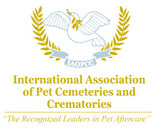 Offering condolences and creating keepsakes are standard practices in most veterinary clinics today. Reaching out to clients after their pet dies is not only a sign of compassion, it is also a wise business practice. For one reason or another, a significant number of clients do not return to a veterinary practice after their pet dies. However, a friendly, concerned contact after the death of a pet can break through this avoidance and denial aspect of grief. It may help to reassure clients that you understand their loss and will welcome them back at any time. The vast majority of pet owners do not view condolences and memorials as morbid, intrusive, silly, or overly sentimental. They view them as sensitive ways for you to honor the deep, special bond they shared with their companion animal.
Offering condolences and creating keepsakes are standard practices in most veterinary clinics today. Reaching out to clients after their pet dies is not only a sign of compassion, it is also a wise business practice. For one reason or another, a significant number of clients do not return to a veterinary practice after their pet dies. However, a friendly, concerned contact after the death of a pet can break through this avoidance and denial aspect of grief. It may help to reassure clients that you understand their loss and will welcome them back at any time. The vast majority of pet owners do not view condolences and memorials as morbid, intrusive, silly, or overly sentimental. They view them as sensitive ways for you to honor the deep, special bond they shared with their companion animal.
Phone Calls and Condolence Notes
Condolence cards and telephone calls should be sent or made as soon after a pet’s death as possible. Whether you’re writing or speaking the words, recall something unique about the pet and refer to it in specific terms. For example, you might say, “I’ll always remember CeeCee’s pretty blue eyes and the long, sweet looks she would give us.” This reassures clients that you are reaching out to them personally and not treating their case as just another statistic.
While you are offering your condolences, you can also invite clients to contact you if they have further questions or concerns. By taking advantage of the opportunity to educate clients about normal grief, you are doing them a great service. If you’re sending a condolence card or note, include printed grief materials and referrals to local pet-loss support groups or pet-loss counselors.
Offering Condolences Face-to-Face
Verbally acknowledge the pet’s death during the first face-to-face, post-death contact you have with your client, even if this is several months after the death in a public place like the grocery store. Use direct eye contact, a quiet voice, and touch (if it seems appropriate) and say something like, “Hello, Jill. I haven’t seen you since CeeCee died. How have you and your family been since then?”
If an after-death conversation is taking place in a public area (the grocery store or your clinic’s waiting room), structure the environment by inviting you client to join you in a more private place (such as a coffee shop next door to the store or your office). You might say, “Jill, it sounds like it might feel good for you to talk a bit about CeeCee, and I’d like to hear more about how you’ve been. Do you have time for a cup of coffee over in the deli?”
If your client begins to cry at the mention of their pet’s name, normalize their tears and give permission to cry and talk about their pet and their feelings of grief. Remember, tears are normal and nothing to be ashamed of. Attend, paraphrase, listen actively, and if appropriate, self-disclose about your own need to talk and to cry after a pet you loved died. You may also encourage your client to find a way to memorialize their pet if they haven’t already done so.
Memorialization Ideas to Provide or Suggest
Most pet owners find it meaningful to have an object that links them to their pet. This object may be a dog’s collar, a cat’s toy mouse, a special blanket, or even a food dish. The object may also be part of the actual animal, such as a feather, a fur clipping, part of a horse’s main or tail, or pawprint set in clay. Remind clients that if these objects comfort them, they may keep them with them or in plain view in their home rather than stuck away in a box or drawer.
Just as there are many ways to offer your condolences to clients, there are many ways you can help clients memorialize their pet. For instance, you can send flowers or make donations to animal organizations or to special service groups in the name of your clients’ pet. You can make ClayPaws prints of the pet’s paws, and you can give clients encouragement to create their own memorials. Many pet owners collect their memories into a scrapbook or photo album or on video.
Putting It All Together
As an example of how to incorporate these ideas, here’s a sample condolence letter:
Dear John, Jill, and Meghan,
I have thought of you so often since CeeCee died. I want you to know that I believe your decision to help her die was the right one. Her cancer had advanced to the point that her quality of life was greatly diminished, and she just wasn’t enjoying life much anymore. During treatment, you did everything you could for her and, in the end, spared her any further pain and suffering.
Our staff made a donation to the local humane society in your sweet CeeCee’s name. I remember you said you adopted her there twelve years ago. We also hope CeeCee’s collar and the clay parint we made of her paw are comforting keepsakes for you. It can be comforting to keep familiar mementos from our pets’ lives.
The next few days and weeks are bound to be sad for you all. I’ve included enclosure cards that provide helpful information about grief and about supporting children through this time. As I said when we spoke yesterday, we care about you and want you to let us know if we can be of any further support to you.
Sincerely,
Jean Wills, DVM, and Your Friends at Animal Care Hospital
You can also check out our Helpful Phrases for Condolence Cards Staff Handout for more ideas. This and other free, printable handouts for your team are available in our Resource Center for Professionals.
Keep up the good work,

Laurel Lagoni
Co-Founder
World by the Tail, Inc.





